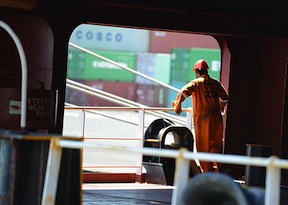The following is the text of a news release from the Seamen’s Church Institute:
(NEW YORK) — The Seamen’s Church Institute (SCI) Center for Seafarers’ Rights, with the assistance of North American Maritime Ministry Association (NAMMA) and other seafarer ministries throughout the United States, conducted its 14th annual Seafarer Shore Leave Survey during the week of May 23-29. The survey aimed to identify difficulties encountered by seafarers in accessing shore leave.
Survey administrators recorded data from nearly 9,500 seafarers on over 400 vessels in 27 ports. Of these seafarers, 1,642 (17.3 percent) were denied shore leave — an overwhelming majority of which because they lacked a valid visa (79 percent). Other reasons for shore leave denials included seafarers who remained on their vessels in United States waters for more than 29 days (7 percent), vessel operations (5 percent), terminal restrictions (4 percent), Customs and Border Protection (CBP) restrictions (1 percent), and restrictions on transit with C-1 visas (1 percent).
The percentage of ships with seafarers detained has increased for the third year in a row in SCI’s annual Seafarer Shore Leave Survey. The rate has reached its highest point (27.4 percent) of the past 12 years. SCI’s 2015 survey also recorded the largest total number of vessels with at least one seafarer denied shore leave (128).
Of the 1,642 seafarers denied shore leave in this year’s survey, 1,300 did not have a valid visa. The United States requires non-American seafarers to obtain crewmember visas in order to apply for shore leave. This directly conflicts with the Convention on Facilitation of International Maritime Traffic (FAL) — of which the United States is a member — prohibiting visa requirements for seafarers. In countries requiring visas for shore leave, the Maritime Labour Convention 2006 (MLC 2006) — which came into effect two years ago — requires that shipowners pay for them. Of the 1,300 seafarers denied shore leave for lack of a valid visa, at least 418 (32 percent) were from countries that have ratified MLC 2006 and have an obligation to ensure seafarers have visas. The survey also reveals flag states that have not held shipowners accountable. Of the 1,044 seafarers without visas, 1,300 were on vessels registered in MLC 2006 member states.
Currently, terminal restrictions present an obstacle for seafarers looking to obtain shore leave. On Dec. 29, 2014, the United States Coast Guard proposed a new rule, which, if implemented, would require terminals to provide timely transit through the terminal at no cost to seafarers. If the Coast Guard’s proposed rule is implemented, it will impact the 4 percent of seafarers from this survey denied shore leave because of terminal access.
Shore leave is not only critical for the health and well-being of seafarers but also for productive and safe vessel operations. Seafarers live out their professional lives on board a ship; they work, live, eat, sleep, and socialize with the same crew for the duration of their contract. Their only respite from these confines comes at the opportunity for shore leave.
Download the complete survey results at http://smschur.ch/shoreleave2015.

